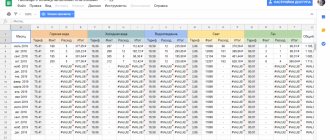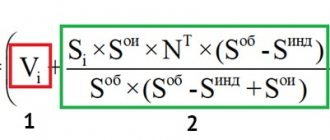What are general house needs
General house needs is a concept that applies only to apartment buildings. According to clause 1 of Article 36 of the Housing Code of the Russian Federation[1], ODN provide energy resources for the operation of non-residential public spaces, this includes:
- power supply to elevators, lighting of basements, attics, front doors;
- heating of these premises in the autumn-winter period;
- water consumption during testing and draining of heating risers;
- costs of maintaining the local area.
What is included in the ODN
Common house needs (CHN) are one of the expense items included in residents’ utility bills. This concept applies only to apartment buildings - in individual residential buildings there is no common housing. The ODN includes ensuring the functioning of household common areas (clause 1 of Article 36 of the Housing Code of the Russian Federation):
- lighting of attics, basements, entrances, elevators, technical rooms;
- electricity necessary for servicing antennas, pumps, operating elevators, etc.;
- heating of these areas;
- water consumption during seasonal inspections of the heating system;
- electricity and water costs for maintaining the local area: watering lawns, lighting the yard.
As previously calculated
Previously, the rules governing the calculation of fees for one-time service were quite vague. Therefore, management companies calculated payments at their own discretion, and residents of some areas were faced with a large difference in tariffs: relatively speaking, one received a payment for 200 rubles, and another for 600. This column in the receipts provided a field for fraudulent actions by housing and communal services workers, but residents did not could check whether the values indicated in their payments are correct. In 2021, a number of reforms were introduced in this area.
Payment changes in 2021
The amount of heat energy required to ensure specified temperatures in the spaces of houses is the standard for heat energy consumption. It is measured in gigacalories per square meter of area per month.
The permissible temperature ranges in the areas of residential buildings are specified in sanitary standards and regulations No. 2.1.2645-10[2].
Since January 1, 2021, amendments to the Housing Code of the Russian Federation have established that the calculation of energy resources used for common premises is carried out according to standards.
The right to set such indicators is given to regional authorities. In some areas, regulations were not updated, and Management Companies were billing much higher fees than previously. This was confirmed during control activities carried out by the Ministry of Construction of the Russian Federation in several regions of the country.
On July 29, 2021, Law No. 258-FZ “On Amendments to Articles 154 and 156 of the Housing Code of the Russian Federation”[3] was adopted, which finally decided that the calculation of contributions for general household needs is based on indicators of metering devices.
The main point of introducing consumption standards for general household needs is to ensure that owners do not pay for excess consumption of water, electricity and heat.
Tariffs for heat energy and approved indicators of consumption of general house needs are posted on the Internet on the websites of housing and communal services companies and portals of local administrations. With this data, residents can check whether fees for energy resources are calculated correctly.
Payment for general house needs: history of introduction, accrual details (table)
History of the introduction of fees for one-way traffic access. Is it legal to pay for one-time service? How fees for general house needs were calculated before, and how they are calculated now.Part 1. Until 09/01/2012
payment for utility services for general house needs (“CU for ODN”) was not provided for by law. However, in some cases, consumers were charged “MOP electricity” on a separate line in the invoice. This happened outside the legal framework, with the goal of “forced coverage of shortfalls in income” of utility service providers.
Until 09/01/2012, all standard losses and expenses for public utility services (cleaning of premises, watering, etc.) were included in the standards for the consumption of utilities. And the widespread installation of individual metering devices at the expense of the population was not among the priorities of the state policy of the Russian Federation (this began with the adoption of Federal Law No. 210 “On Energy Saving...”).
Part 2. From 09/01/2012
new Rules for the provision of utility services came into force (Resolution of the Government of the Russian Federation dated 05/06/2011 No. 354, as amended on 05/04/2012 No. 442), according to which charging consumers of an apartment building a separate fee for utilities on the ODN became legal .
In accordance with clause 40 of the Rules:
Utilities provided for general house needs
are utilities consumed during the use of common property in an apartment building.
The rules for establishing and determining standards for the consumption of utility services (Resolution of the Government of the Russian Federation dated May 23, 2006, No. 306, as amended on March 28, 2012, No. 258) define what is included in the standards for the consumption of utility services for general household needs:
29. Standards for the consumption of utility services for general house needs
for each type of utility service include regulatory technological losses of utility resources and do not include the costs of utility resources resulting from violation of the requirements for the technical operation of intra-building engineering systems, rules for the use of residential premises and the maintenance of common property in an apartment building. The standard consumption of utility services for wastewater disposal for general house needs is determined based on the sum of the standards for the consumption of utility services for cold water supply and hot water supply for general house needs.
Part 3. Table. When and how is the payment for one-time service calculated? Resolution 307 (repealed)
| Resolution 354 (in force) | |||||
| Options for equipment with metering devices | Until 06/08/2011 | From 06/08/2011 to 09/01/2012 | Options for equipment with metering devices | From 01.09.2012 | Special case - Udmurtia: from 09/01/2012 to 01/01/2014 (approximately) |
| Apartment without meters | Payment for utility services is charged to the consumer according to the calculation formula (formula 3) in one line. The payment for the consumption of utilities for one-way service is included in the total amount of the payment for the utility service, because consumption of heat treatment units for one heating unit is included in the consumption standards (water, heat, electricity, gas) initially. In some cases (there is a general house meter and there is not a single individual one), the payment for utility services is charged to the consumer according to the calculation formula (formula 6*): individual estimated consumption of the CP and CP for one unit together. Separate fee for “UKU for one service station” or “utility service MOP”, etc. - ILLEGAL. | Payment for utility services is charged to the consumer according to the calculation formula (formula 9*) in one line: individual standard consumption of CG and CG for one unit together. In some cases (there is a general house meter and there is not a single individual one), the payment for the consumption of utility services is charged to the consumer strictly according to consumption standards (formula 3). The consumption of utilities for one-room heating equipment is included in the standards for the consumption of utilities from the very beginning. Separate fee for “UKU for one service station” or “utility service MOP”, etc. - ILLEGAL. | A house without a common house meter | The payment for CG at one single service point is charged to the consumer as a separate line for each type of service (except for gas and, in some regions, heating) according to a separate consumption standard for CG at one single point (formula 10 + formula 15). Consumption standards are divided into individual consumption and general household consumption. A separate payment “KU for one day” is legal. | Standards for the consumption of HRVs at one-stage heating units have not been approved. There are no grounds for charging CG fees to ODN. |
| Apartment with metering devices | The payment for the consumption of utility services is charged to the consumer according to the calculation formula (formula 9*) in one line: individual estimated consumption of CG and CG for one unit together. CG expenses for one-room service are included in the total amount according to the calculation*. Separate fee for “UKU for one service station” or “utility service MOP”, etc. - ILLEGAL. | House with a communal meter | The payment for CG at one-way service is charged to the consumer as a separate line for each type of service (except for gas and, in some regions, heating) according to the calculation formula (formulas 10, 11, 12*). A separate payment “KU for one day” is legal. | [same as in the cell on the left, no deviations] | |
Note: *The final payment amount for a specific consumer is influenced by the readings of the common house meter, the number of registered/unregistered consumers in the house, and the total consumption of other individual metering devices, if any.
For reference: all formulas for calculating fees for utility services that were in effect during different periods of time.
Calculation of payments in apartment buildings
If there is a common house meter, the calculation of payment for heating one heating unit is carried out as follows:
- the data from the metering device of the incoming heat network is recorded;
- data from apartment flow meters is recorded and summarized;
- the difference in values is calculated;
- the result obtained is divided by the number of apartments taking into account their area;
- then the figures are compared with the consumption standard;
- if the amount of consumption does not exceed the established norm, then it is paid in full;
- if the consumption value is higher, then the owners pay for heat according to the standard; the amount above the established indicator is paid by the management organization.
If there is no common house meter, then to calculate the payment for heat supply, the area of common property is multiplied by the heat tariff. Then the received amount is distributed among the apartments in proportion to their area.
You can also calculate other services on ODN:
- for electricity;
- for drainage;
- for water supply.
What is the problem
The owner of a residential premises in an apartment building appealed to the Supreme Court of the Russian Federation. She was outraged by the illegal charging for electricity above the approved standards. The owner made a claim against both RSO and UO simultaneously.
It would seem that everything is simple - the house is managed by a management organization. She is the executor of the utility bill, so she issues receipts for utility bills on ODN . But the UO and RSO did not enter into an energy supply agreement and RSO issues receipts directly to residents.
The case went through two trials before ending up before the Supreme Court. The city court ordered RSO to recalculate and pay legal costs. He also obliged us to conclude a resource supply agreement with the management company.
The regional court upheld the decision to conclude the contract, but canceled the requirement for recalculation, payment of legal costs and a fine. The owner, having failed to achieve her goal, appealed to a higher court.
Let's see what logic the Supreme Court followed and how it judged the conflict between the RSO, residents and the management authority.
Post-release of the webinar “Reducing the costs of one-stop service”
66170
Payment order
Starting from 2021, expenses for one-time services are shown in receipts along with general household expenses. Owners pay utility bills according to the types of resources consumed and general household expenses. For information of citizens, information about the area of the building and the common area of the building is printed in the accounts.
In a house where meters are installed at the entrance to the house heating network, the actual consumption of heat energy has priority. Therefore, measures to save heat (insulating facades, roofs, installing double-glazed windows in staircases, insulating entrance doors) will allow residents to save on heating fees.
So who should I pay?
The court found that the payment for electricity at ODN was indeed collected by RSO. She did not enter into an agreement with the UO. To account for electricity in the house, an ODPU was installed, readings from the meter were taken monthly by the management organization and the RSO.
Residents of apartment buildings and organizations that rent premises in the house must pay for utilities (Articles 153, 154 of the Housing Code of the Russian Federation).
Another responsibility of residents is to choose one of three methods of managing apartment buildings:
- direct control,
- management of HOA or residential complex,
- management organization.
If residents choose a management organization, it provides them with a full range of utility services. It is impossible to provide only part of the utilities and not purchase electricity.
The Supreme Court of the Russian Federation agreed that owners and tenants of residential premises, by decision of the OSS, can pay for all or some utilities directly to the RSO. But in this way it is impossible to pay for the utility bills consumed for the maintenance of common property in the apartment building .
The management organization enters into a resource supply agreement with the RSO and only after that provides utilities to the residents of the apartment complex (clause 13 of RF PP No. 354). The management authority enters into an agreement with the RSO for the supply of all utility resources that are necessary to maintain the apartment building and ensure the comfort of residents.
If the house is managed by the management authority, residents pay it for the consumed utilities, unless they have made a different decision at the OSSS. It turns out that the residents of the apartment building in this case act as consumers of the utilities, and the management company is both the executor of the utilities and the subscriber in relation to the RSO.
We put all the facts together and conclude that the procedure for paying for CG directly depends on the chosen method of managing MKD . But the organization determined by the general meeting of owners can charge and collect fees.
At the time of the proceedings, the wording of Part 7.1 of Art. 155 of the Housing Code of the Russian Federation, which did not allow direct payment of the CU on the ODN directly to the RSO. There was an exception - you can pay directly to RSO if you are directly managing the MKD . But in our case, the house was managed by the MA.
The executor of the CG was the management organization, and it had every right to charge fees for the services provided. The management organization had to be paid.
Door-to-door visits as a way to reduce ODN. Interview with Nikolai Fedotov
146350
Possible changes in the new year in general house needs
The government plans to include the costs of one-time service expenses into the total cost of a communal apartment, which will completely remove the column of expenses for one-time expenses. Also, subjects will be able to independently establish standards for calculating general household needs. The authorities planned to introduce similar changes back in 1616.
According to the authorities, this will make the process of calculating utility bills more transparent. Also in 17, the government decided to increase the cost of utility bills. It was assumed that the increase would be from 2.5% to 7.5%. Already at the beginning of July, citizens were able to experience the increased costs of utility bills.
It is worth noting that due to the fact that utility networks are in a deplorable state, there is a large loss of resources, which leads to an increase in ODN. Despite the fact that citizens pay their utilities in good faith, companies are unable to update networks due to insufficient funds, which ultimately often leads to negative consequences. According to experts, fundamental measures are required in the reform of housing and communal services. All that remains is to wait for the new year to see how much utility prices will rise and whether the innovations will bring positive results.
Emergency and dilapidated housing, redevelopment
The calculation formulas provide for zero thermal energy consumption
On January 1, 2021, changes to RF PP No. 354 introduced by RF PP No. 1708 came into effect. In the rules for calculating heating fees, an option appeared when the volume of thermal energy consumed in the room is zero.
The volume of individual consumption – Vi – is equal to zero in the case when there are no heating devices in this room at all or when individual apartment sources of thermal energy are used.
But the size of the heating fee consists not only of individual consumption within the owner’s premises. For example, the formula for an apartment building that is not equipped with a common building meter and in which payment is made during the heating season:
Payment consists of two parts:
1. For the volume consumed indoors.
2. For the amount spent on general house needs.
All other formulas - for calculating fees in a house with shared ownership or paying fees throughout the year in equal shares - follow the same logic. Consequently, the owner, even having abandoned centralized heating inside his apartment, must pay for the thermal energy supplied to maintain the common property of the apartment building.








